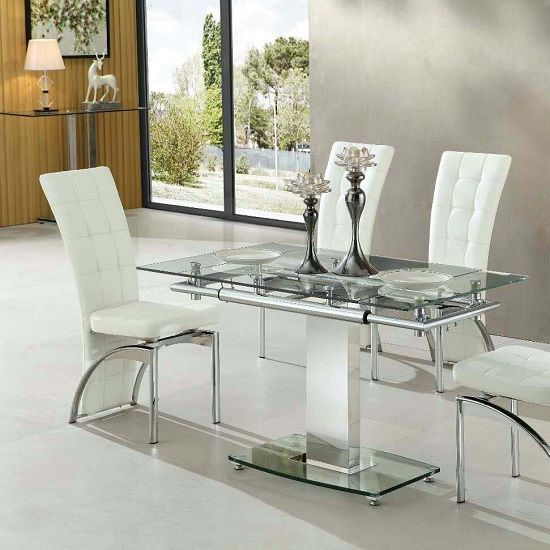Glass dining tables can make a striking and elegant statement in any dining space when chosen and styled thoughtfully. Here’s an in-depth look at the pros and cons of glass tabletops to help you decide if one is right for your home.

The Pros of Glass Dining Tables
Visual lightness and space
One of the biggest advantages of glass tabletops is that they give the illusion of taking up less visual space than their solid wood or stone counterparts. Their airy, transparent quality makes rooms feel more open and bright. This helps small dining spaces feel more spacious, while enlarging the feeling of more generous rooms.
Glass tops allow diners to see and appreciate the bases and legs of dining tables, rather than having them obscured by an opaque surface. This shows off beautiful materials and craftsmanship. The transparent surface creates a lightweight, floating effect in contrast to the solid base.
Reflects light beautifully
The reflective qualities of glass dining surfaces make them perfect for bringing more light into dining spaces. They beautifully reflect both natural and artificial light sources, helping rooms feel sunnier and more radiant. Candlelight bounces softly off the tabletop, creating a romantic glow.
Versatile with any decor
The neutral, transparent look of glass dining tables complements practically any style of dining chairs, centerpieces and surrounding decor. A glass surface won’t fight visually with any color palette or materials, seamlessly fitting into diverse aesthetics from traditional to modern.
You can dramatically switch up the feel of a glass top table by changing bases and dining chairs. The versatility of glass tops makes redecorating easy, without needing to replace the table itself.
Easy to clean and maintain
Glass tabletops are much simpler to clean than surfaces like wood that can stain and show wear over time. Their perfectly smooth finish just needs an occasional wipe down to keep them looking crystal clear.
Since glass doesn’t show scratches, heat marks or dings, it’s very durable and resistant to normal wear and tear. This saves the work of refinishing or conditioning the tabletop to keep it looking pristine.

The Cons of Glass Dining Tables
Prone to smudging and fingerprints
While glass tabletops don’t show scratches, their smooth surfaces do highlight every single fingerprint and smudge. Frequent polishing is a must for those wanting to keep that just-cleaned look. Diligent maintenance is required to prevent visible fog and streaks.
Susceptible to chipping and cracking
While resistant to scratches, glass tops are vulnerable to chipping and cracking. A sharp blow from an object or edge can cause noticeable damage. Over time, the expansion and contraction of the glass can cause tiny stress fractures.
This makes glass less durable and sturdy overall than natural stone or hardwood. It’s important to exercise some care to prevent heavy objects from banging into or falling on the surface.
Can be noisy
The hard, flat surface of glass dining tables amplifies noise from above. The acoustics of an uncovered glass top can make for noisy dining when dishes, utensils and glasses clash and clatter. Tablecloths, rug pads and centerpiece arrangements can help muffle sound.
Shows watermarks
The visibility of every fingerprint also applies to watermarks. Condensation from glasses can leave wet rings, as can errant spills and splashes from cooking or cut flowers. These spots evade scratches but are still unsightly blemishes. Prompt wipe-ups are key to prevent lingering liquid marks.
Temperature sensitivity
Glass tends to stay cool to the touch until warmed by hot dishes. Sudden temperature changes from boiling liquids or very hot plates can lead to cracking or shattering. Using trivets and coasters helps prevent thermal shock.
Can feel cold and hard
The sleek feel of glass comes from its cool, solid smoothness. But some may find an uncovered glass dining surface slightly cold and hard compared to the warmth and give of wood. Tablecloths and place mats can make the table more comfortable.

Making a Glass Tabletop Work
With its stylish lightness balanced by some practical considerations, a glass dining table requires care and intentional styling. Here are some tips for making the most of a glass top:
- Add a tablecloth, place mats or table runners to soften and mute
- Incorporate plantlike and table decor to disguise smudges
- Use trivets and coasters for hot dishes
- Select substantial bases for visual and physical balance
- Opt for tempered glass for thermal resilience
- Consider etched glass for a frosted look with grip
- Pair with lighting that casts a warm glow on the surface
With creative design choices and care in use, a glass dining table can be a stunning yet practical focal point. The transparency of glass elevates dining spaces with its beauty and visual lightness. A smart pairing with the right accents makes this material a polished option.










